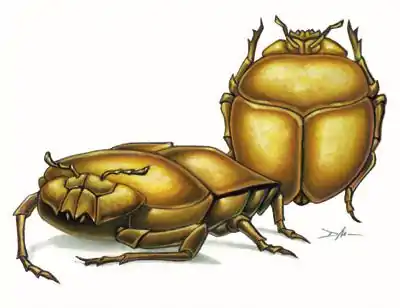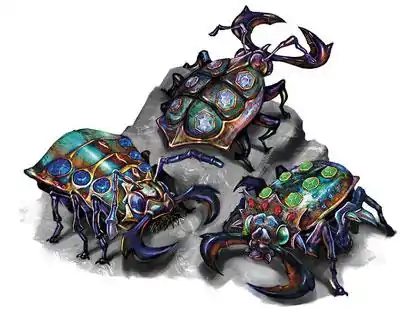Beetle (4e Creature)
Some species of beetles are innocuous and even beneficial, feeding off of carrion and refuse that would otherwise pile up around large cities, but others, particularly amongst the monstrous varieties, can be a dangerous hazard for even experienced adventurers.
Giant Beetle
|
There are a number of large, mostly harmless beetles referred to simply as giant beetles. They are not considered dangerous, as they attack only if bothered, but can be a threat to small children and animals, who may unknowingly distress the creatures. Still, they are usually driven off, as they feed primarily on vegetation and can devastate crops. Giant Beetle TacticsIf possible, giant beetles prefer to avoid combat, but bite if threatened or startled. They are often found in large groups, which might be dangerous if they are all startled at once. Giant Beetle LoreA character knows the following information with a successful Nature check. DC 15: Giant beetles are considered harmless, only being a threat to those who attack them. | ||||||||||||||||||||||||||||||||||||||||||||||||||||||||||||||||||||||||||||||||||||||||||||||||||||||||||||||||||
Hoard Scarab, Variant
|
Also known as a thief's bane beetle, hoard scarabs possess a shiny, metallic shell that comes in many shades of silver or gold. When the sightless creature is inactive, particularly if it burrows in the sand and leaves only its back exposed, it looks exactly like a valuable coin — by the time a would-be treasure seeker realizes his mistake, it is often too late, as the parasitic scarab wastes no time burrowing into the unfortunate victim's flesh. Hoard scarabs are greatly feared in the desert regions they call home because they will often nest amongst actual coins, a habit which gives them their name, and can easily kill those that don't keep their wealth in a secure location; a popular phrase states that greed is the deadliest sin in the desert. Even the occasional young dragon has been forced to give up its hoard because of a scarab infestation. Note: The hoard scarab officially appears in Draconomicon. The version presented here is meant to convert the scarab into a lurker, which is more in line with its lore, and to give it a couple extra abilities to help it fill that role. Hoard Scarab TacticsHoard scarabs lie in wait just beneath the surface of the sand, or hidden amongst a pile of coins, and waits for a creature to get close enough for it to bite. The scarab immediately attacks the closest creature with its burrowing bite ability and will relentlessly tear into it until the victim dies. In massive groups, hoard scarabs can reduce a human to nothing but bone in a matter of seconds. Hoard Scarab LoreA character knows the following information with a successful Nature check. DC 15: Hoard scarabs are desert-dwelling beetles that resemble coins when inactive. They feed by burrowing into the flesh of other creatures, most of whom fall victim to its attacks because they attempt to "collect" the beetle. | ||||||||||||||||||||||||||||||||||||||||||||||||||||||||||||||||||||||||||||||||||||||||||||||||||||||||||||||||||||||||||||||||||||||||||||||||
Gem Scarab
|
Gem scarabs are brilliantly-colored beetles that feed primarily off of gemstones and other precious minerals, but they will also consume other creatures that pass by while they are submerged in the earth. Each individual possesses a unique ability, which seems to be tied to the color of the gem formations on its body and what type of gem it consumes the most of — those that feed mostly on rubies, for example, can produce a ray of fire. Because of the similarities in their habits and appearance, many assume that gem scarabs and hoard scarabs are related or even different varieties of the same creature. Gem Scarab TacticsGem scarabs are creatures of instinct, relying almost wholly on their gem power for protection, and they prefer to strike from just below the surface of the ground. They bite only if the foe proves susceptible to nothing else. Gem Scarab LoreA character knows the following information with a successful Arcana check. DC 15: Gem scarabs are beetles that feed on flesh and precious minerals. The gemstones that they consume allows them to store energy that they then turn into a variety of quasi-magical effects. | |||||||||||||||||||||||||||||||||||||||||||||||||||||||||||||||||||||||||||||||||||||||||||||||||||||||||||||||
Hoard Scarab Swarm
A hoard scarab swarm is a mass of individual beetles gathered in a single small space; some are simply large groups that happen to live in close proximity, while others are coerced by outside forces to gather into a swarm. The sheer number of individual scarabs in a swarm necessitates that they disguise themselves as literal piles of coin, rather than scattered pieces, which makes them all the more deadly when a victim goes to grab one — the entire mound rears up and engulfs the hapless creature. Tales tell of a hidden vault within the desert piled to the roof with treasure that sometimes moves about, but woe to the creature that finds it.
|
Hoard Scarab Swarm TacticsA swarm behaves much as an individual hoard scarab, but to much more dramatic effect. Their swarm attack aura enables them to bore into multiple creatures at once, and they can easily overwhelm small groups of weaker creatures. | |||||||||||||||||||||||||||||||||||||||||||||||||||||||||||||||||||||||||||||||||||||||||||||||||||||||||||||||||||||||||||||||||||||||||||||||||||||||||||||||||||||||||||||||
Hoard Scarab Swarm Lore
A character knows the following information with a successful Nature check.
DC 15: Hoard scarab swarms are groups of thousands of individual beetles gathered together that act in concert with one another. They can devour exceptionally large creatures the size of elephants in moments.
Bombardier Beetle
Bombardier beetles possess highly-developed chemical glands in their abdomen that can be used to spray an acidic mist in a surprisingly large spread. Originally a defensive mechanism, monstrous bombardier beetles have adapted to use it as their primary means of killing prey. Although they are not overly aggressive and will usually ignore anything besides its usual prey of small animals, bombardier beetles will attack if startled. They can be found in a wide range of habitats and climates, able to adapt to nearly any food source, and are sometimes kept by more primitive races for protection.
|
Bombardier Beetle TacticsA bombardier beetle relies almost exclusively on its acid spray ability to kill prey and ward of predators. It bites only when caught in close combat or it is unable to use its spray. | |||||||||||||||||||||||||||||||||||||||||||||||||||||||||||||||||||||||||||||||||||||||||||||||||||||||||||||||||||||||||||||||||||||||||||||||||
Bombardier Beetle Lore
A character knows the following information with a successful Nature check.
DC 15: Bombardier beetles attack prey with a quick spray of acid from their abdomen. It can do so repeatedly, though it must wait a short period between each spray.
Rhinoceros Beetle
Rhinoceros beetles are among the largest of their kind, growing to lengths of up to 20 feet. The males possess two horns — one attached to their head and another growing straight from their shell, though the latter is used much more frequently — that serve to drive off predators as well as other males during the mating season, and their shells are often brightly colored. Females are much larger than males, sometimes exceeding 30 feet, but they lack horns, possess dull brown or grey chitin, and are encountered much less frequently. The males of the species are unpredictable and prone to attacking without provocation, especially during the mating season, while females will typically ignore anything that doesn't bother them — both, however, are formidable if riled.
|
Rhinoceros Beetle TacticsA rhinoceros beetle charges the nearest opponent, which can be devastating thanks to its concussive charge ability. If foes are clustered together, it will use trample to attack multiple targets at once, but it otherwise simply relies on its horns to gore its foes. | |||||||||||||||||||||||||||||||||||||||||||||||||||||||||||||||||||||||||||||||||||||||||||||||||||||||||||||||||||||||||||||||||||||||||||||||||||||||||||||||||||||||||||||||||||||||||||||||||||||||||||||||||||||||||||||||||||||||||||||||||||||||||||||||||||||||||||||||||||||||||||||||||||||||||||||||||||||||||||||||||||||||||||||||||||||||||||||||||||
Rhinoceros Beetle Lore
A character knows the following information with a successful Nature check.
DC 15: Male rhinoceros beetles are aggressive, territorial insects that attack with no provocation whose powerful horns can easily impale a victim. Females are more docile and usually don't attack unless disturbed.
Siege Beetle
Siege beetles were originally bred by demons to serve as living assault weapons, but many now run rampant across the Abyss and even parts of the Elemental Chaos; their handlers quickly realized that the beasts are more trouble than they are worth. They are terribly destructive creatures and will attack anything and everything that moves (their "masters" included); though many would gladly see the creatures eliminated entirely, most prefer to give the beetles a wide berth rather than fight them. Occasionally a powerful demon will open a portal to the Material Plane and let a siege beetle wander through simply to watch the ensuing destruction, and the effect is certainly devastating: entire cities have simply disappeared without a trace because of a marauding siege beetle.
|
Siege Beetle TacticsA siege beetle is a straightforward combatant, relying on brute force to overcome any obstacles it may face. It will use its paralyzing bite against the same target repeatedly after grabbing it with an impaling claw. If multiple foes assault it at close range, it uses surging trample to attack them all at once and knock them away. Once it has used its blinding musk, a siege beetle will typically use its surging trample much more frequently. Siege Beetle LoreA character knows the following information with a successful Arcana check. DC 25: Siege beetles are colossal insects bred for war by demons deep within the Abyss. They are sometimes purposefully sent to the Material Plane to bring destruction and chaos. | |||||||||||||||||||||||||||||||||||||||||||||||||||||||||||||||||||||||||||||||||||||||||||||||||||||||||||||||||||||||||||||||||||||||||||||||||||||||||||||||||||||||||||||||||||||||||||||||||||||||||||||||
Encounter Groups
Beetles are usually encountered by themselves or as pets and guardians to other creatures. Greenscale lizardfolk are commonly known to keep bombardier beetles near their settlements. Hoard scarabs and hoard scarab swarms can be found nearly anywhere in desert environments, either in hiding or infesting other creatures.
Level 1 Encounter (XP 500) — Infested Giant Beetles
- 8 giant beetles (level 1 minion)
- 3 hoard scarabs (level 1 lurker)
Level 7 Encounter (XP 1,500) — Greenscale Hunting Party
- 2 bombardier beetles (level 6 artillery)
- 2 greenscale darters (level 5 lurker)
- 2 greenscale hunters (level 4 skirmisher)
- 1 greenscale marsh mystic (level 6 controller)
Level 28 Encounter (XP 64,700) — Chaosguard of Orcus
- 6 abyssal ghoul myrmidons (level 23 minion)
- 1 deathpriest hierophant (level 21 elite controller)
- 2 glabrezus (level 23 elite brute)
- 1 siege beetle (level 24 solo soldier)
Back to Main Page → 4e Homebrew → Creatures → Level 1
Back to Main Page → 4e Homebrew → Creatures → Level 2
Back to Main Page → 4e Homebrew → Creatures → Level 5
Back to Main Page → 4e Homebrew → Creatures → Level 6
Back to Main Page → 4e Homebrew → Creatures → Level 9
Back to Main Page → 4e Homebrew → Creatures → Level 24






.png.webp)
.png.webp)
.png.webp)

